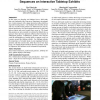Free Online Productivity Tools
i2Speak
i2Symbol
i2OCR
iTex2Img
iWeb2Print
iWeb2Shot
i2Type
iPdf2Split
iPdf2Merge
i2Bopomofo
i2Arabic
i2Style
i2Image
i2PDF
iLatex2Rtf
Sci2ools
CHI
2011
ACM
2011
ACM
Gestures in the wild: studying multi-touch gesture sequences on interactive tabletop exhibits
In this paper we describe our findings from a field study that was conducted at the Vancouver Aquarium to investigate how visitors interact with a large interactive table exhibit using multi-touch gestures. Our findings show that the choice and use of multi-touch gestures are influenced not only by general preferences for certain gestures but also by the interaction context and social context they occur in. We found that gestures are not executed in isolation but linked into sequences where previous gestures influence the formation of subsequent gestures. Furthermore, gestures were used beyond the manipulation of media items to support social encounters around the tabletop exhibit. Our findings indicate the importance of versatile many-to-one mappings between gestures and their actions that, other than one-to-one mappings, can support fluid transitions between gestures as part of sequences and facilitate social information exploration. Author Keywords direct-touch interaction, ...
CHI 2011 | Human Computer Interaction | Information Exploration | Interaction Styles | Vancouver Aquarium |
| Added | 25 Aug 2011 |
| Updated | 25 Aug 2011 |
| Type | Journal |
| Year | 2011 |
| Where | CHI |
| Authors | Uta Hinrichs, Sheelagh Carpendale |
Comments (0)

